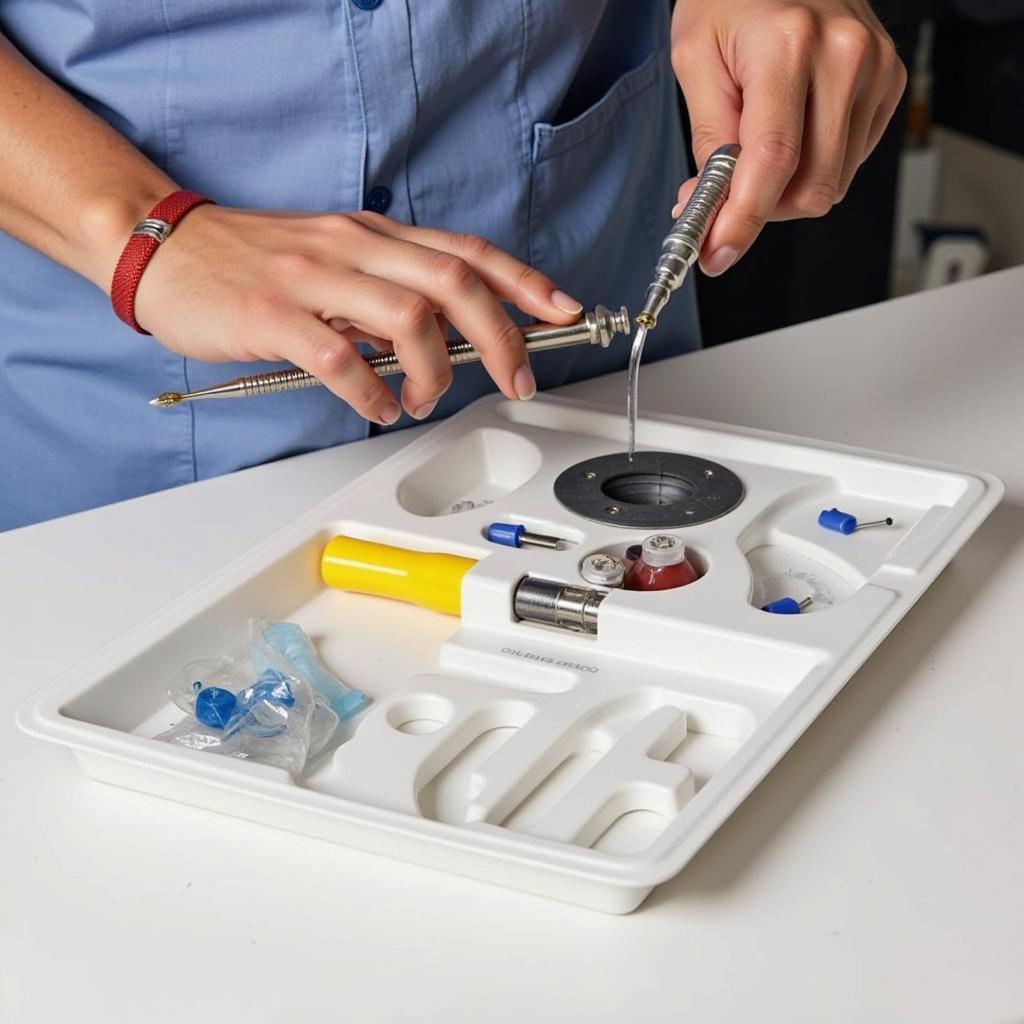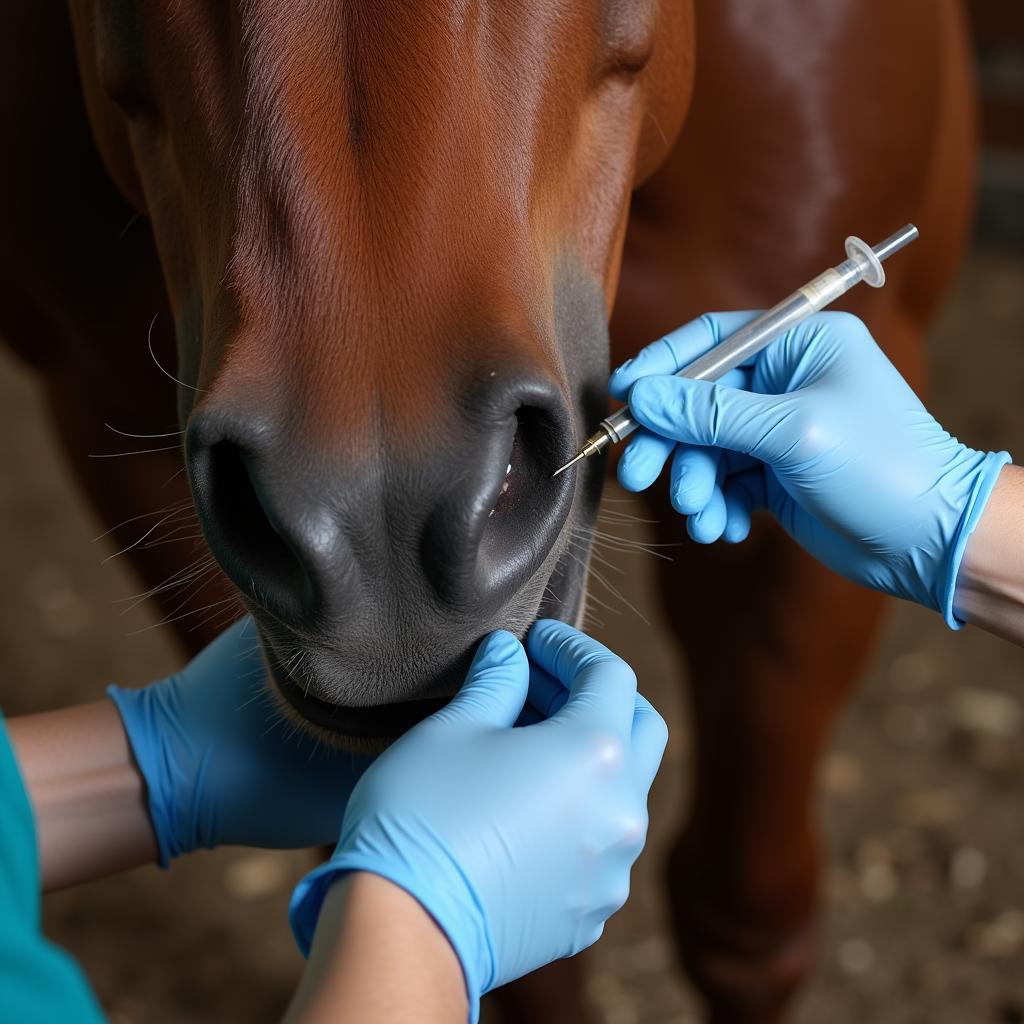Horse Insemination Equipment is an essential investment for any breeder looking to optimize their breeding program. Whether you’re a seasoned professional or just starting out, understanding the different types of equipment and how to use them effectively is crucial for achieving high conception rates and healthy foals. This comprehensive guide will delve into the world of horse insemination equipment, providing you with the knowledge and resources to make informed decisions for your breeding operation.
 Artificial Insemination Kit for Horses
Artificial Insemination Kit for Horses
Essential Equipment for Artificial Insemination in Mares
Artificial insemination (AI) in horses requires a specific set of tools and equipment to ensure the safe and hygienic collection, handling, and deposition of semen. Here’s a closer look at the essential components:
- Artificial Vagina (AV): The cornerstone of semen collection, an AV simulates the natural breeding environment to encourage ejaculation. It consists of a sturdy outer casing, a soft, warm inner liner, and a collection container.
- Breeding Phantom: A breeding phantom provides a safe and stable platform for the stallion to mount during semen collection. It mimics the shape and size of a mare, reducing stress on both the stallion and the handlers.
- Microscope: Essential for evaluating semen quality, a microscope allows you to assess sperm motility, morphology, and concentration, ensuring you’re using viable semen for insemination.
- Insemination Pipettes: These long, slender tubes are used to deposit the semen into the mare’s uterus. They come in various sizes and designs to accommodate different mare anatomies and insemination techniques.
 Veterinarian Preparing Horse for Insemination
Veterinarian Preparing Horse for Insemination
- Speculum: A speculum is used to visualize the mare’s cervix during insemination. It gently opens the vaginal canal, allowing for accurate and hygienic placement of the insemination pipette.
- Gloves and Lubricant: Maintaining sterility is crucial throughout the insemination process. Using sterile gloves and a non-spermicidal lubricant ensures the semen’s viability and minimizes the risk of infection.
Choosing the Right Equipment: Factors to Consider
Selecting the appropriate horse insemination equipment depends on several factors specific to your breeding operation:
- Frequency of Use: If you’re breeding a large number of mares, investing in durable, high-quality equipment is essential. For occasional breeding, a more basic setup might suffice.
- Budget: Horse insemination equipment can range widely in price. Determine your budget and prioritize essential items while considering the long-term cost-effectiveness of higher-quality options.
- Experience Level: If you’re new to AI, opting for user-friendly equipment and seeking guidance from experienced breeders or veterinarians is highly recommended.
Maintaining Your Horse Insemination Equipment
Proper maintenance of your equipment is crucial for ensuring its longevity and preventing contamination. Here are some key tips:
- Cleaning: Thoroughly clean and disinfect all equipment after each use. Follow the manufacturer’s instructions and use appropriate cleaning solutions.
- Storage: Store equipment in a clean, dry environment to prevent damage and the growth of bacteria or mold.
- Regular Inspections: Regularly inspect your equipment for wear and tear, replacing any damaged parts promptly.
 Horse Breeding Chute
Horse Breeding Chute
“Investing in high-quality horse insemination equipment is just as important as selecting the right stallion. It’s an investment in the health of your mares and the success of your breeding program.” – Dr. Emily Carter, Equine Reproduction Specialist
Beyond the Basics: Advanced Insemination Tools
As you gain experience and expand your breeding program, you might consider these advanced tools:
- Portable Ultrasound Machine: An ultrasound machine allows you to monitor follicular development in your mares, accurately timing insemination for optimal results.
- Semen Extenders: Semen extenders preserve the viability of stallion semen, allowing for storage and transportation. This is particularly beneficial when using cooled or frozen semen.
Conclusion
Choosing the right horse insemination equipment is a critical step towards successful equine breeding. By understanding the various types of equipment, factors influencing your selection, and the importance of proper maintenance, you can make informed decisions that support the health of your mares and the success of your breeding program. Remember, investing in quality equipment and prioritizing hygiene are paramount to achieving high conception rates and welcoming healthy foals.
Frequently Asked Questions
- What is the average cost of a basic horse insemination kit? The price can vary but expect to invest around $500 to $1000 for a basic kit containing essential items like an AV, insemination pipettes, and a speculum.
- Can I perform AI on my mares myself? While it’s possible to learn the techniques, it’s highly recommended to seek guidance from an experienced veterinarian or breeding professional, especially for your first few attempts.
- How do I know if my mare has successfully conceived after AI? A veterinarian can perform an ultrasound examination around 14-16 days post-insemination to confirm pregnancy.
Need More Information?
- Learn about using a horse with condom for natural breeding.
- Explore options for a breeding chute for horses to ensure safety during breeding.
- Find a comprehensive horse stud kit to meet all your breeding needs.
For personalized guidance and assistance in choosing the right horse insemination equipment for your needs, contact Justus Horses USA at 0772127271 or [email protected]. Our team of experts is available 24/7 to answer your questions and help you achieve your breeding goals. Visit our facility at QGM2+WX2, Vị Trung, Vị Thuỷ, Hậu Giang, Việt Nam, to explore our wide selection of horse insemination equipment and receive expert advice.